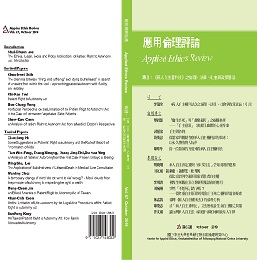2015 年 12 月 18 日,台灣立法院通過了病人自主法案《病主法》。三年後,該法在 2019 年 1 月 6 日正式施行。根據衛生福利部,《病主法》是全亞洲第一部完整保障病人自主權利的專法,意味著病人自主的里程碑。然而,儘管《病主法》的倫理價值在於提供病人在醫療決定上擁有決定權,該法自身的設計會依照不同情境脈絡和文化而有所差異。在美國,《病主法》的三個目的即是透過教育保障病人擁有接受或拒絕醫療的權利、提倡預立醫囑在個人喪失行為能力時的更大表述以及減低生命末期的治療費用。有別於美國,台灣的《病主法》設計源自於三個目的:尊重病人在醫療決定上的自主性、保障善終權益以及促進醫病關係和諧。儘管西方生命倫理學原則傾向於視自主原則為基於自我或個人自主原則,東方視角明顯採用基於家庭的徑路。因此,本文旨在探討在不同社會和文化脈絡下,自主是如何被激發的?具體來說,透過探討《病主法》,家庭之間的親密關係可能如何影響個人自主行為。本文將採用東西方比較法進行探討。
On December 18, 2015, the Legislative Yuan of Taiwan has passed the Patient Right to Autonomy Act (PRAA). Three years later on January 6, 2019, the act is officially implemented. According to Ministry of Health and Welfare, Taiwan Patient Right to Autonomy Act is the first of its kind among Asian nations, signifying the milestone of patient autonomy of the country. Nonetheless, although the ethical value of PRAA is to offer patient Right to decide on medical decision, how PRAA is designed matters contextually and culturally. In the United States, the three main goals of Patient Self Determination Act (PSDA) are providing education regarding individual’s Right to accept or refuse treatment, promoting greater formulation of advanced directives (ADs) if one becomes incapacitated, and reducing end-of life treatment cost. Unlike the States, Taiwan designed its PRAA for three main objectives: respecting patient autonomy in medical decision, ensuring the Right to good death and improving physician-patient relationship. While western bioethical principles tend to regard principle of autonomy as self-based or individualistic autonomy, the Asian perspective distinctly adopts a family-based approach. This paper thus aims to explore how autonomy stimulates within different social and cultural context, specifically how intimate relationship of the family might affect the behavior of individual autonomy through examining PRAA and its comparison with PSDA. An east-west comparison is sought.
